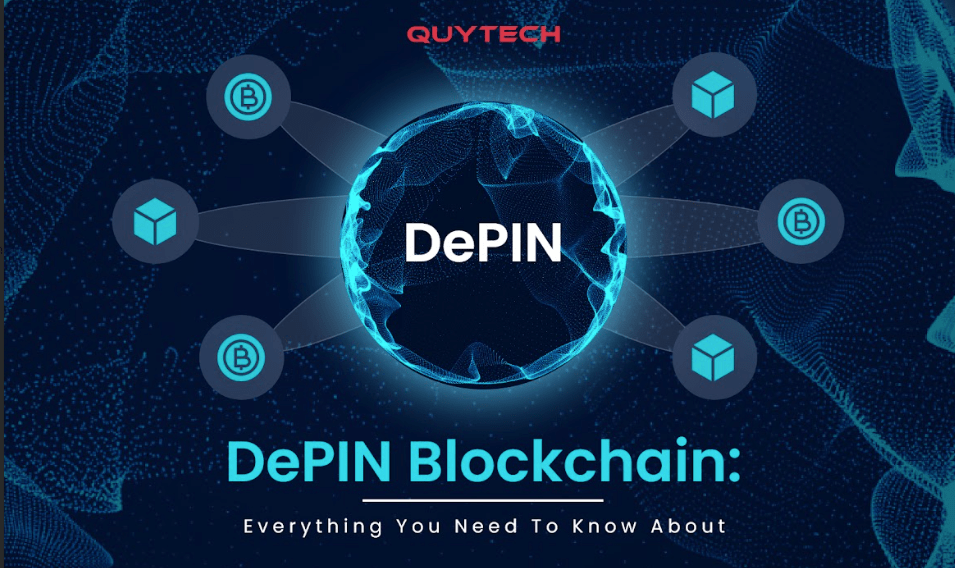Decentralized Physical Infrastructure Networks, or we can say DePINs, are gaining the attention of businesses who have realized DePIN’s potential to manage physical hardware services in a decentralized way.
This is the reason DePIN exceeds $25 billion in market capitalization (as of February 2024).
Source: Crypto.com
Thus, if you want to know more about DePIN, its working, and why it is required, this blog is worth reading!
In this blog, Quytech has explained everything about DePIN (decentralized physical infrastructure network) in detail. So, let’s get started.
Introduction to DePIN
DePIN, or Decentralized Physical Infrastructure Networks, is a decentralized network in which users offer physical infrastructure resources, such as sensors, data storage, or wireless connectivity, open for public use. In return, the contributors are rewarded with DePIN tokens.
Categories of DePINs
DePINs are classified into two types:
- Physical Resource Networks (PRNs)
Physical Resource Networks (PRNs) reward contributors who provide location-dependent hardware goods and services. Examples are energy, connectivity, mobility, and more. Location matters in PRNs.
- Digital Resource Networks (DRNs)
On the other side, Digital Resource Networks (DRNs) reward contributors who provide fungible digital resources. Examples include storage, computer networks, or bandwidth. In DRNs, location is not that important.
Therefore, this is the difference between the two categories of DePIN: PRNs and DRNs.
Working of Decentralized Physical Infrastructure Network
The Decentralized Physical Infrastructure Network (DePIN) works as follows:
- Decentralized Governance
DePIN operates on blockchain networks, such as Solana, Ethereum, Polygon, and others.
The decentralized governance mechanisms allow members and stakeholders to participate in decision-making processes within the DePIN.
- Peer-to-Peer Infrastructure Sharing
DePIN allows peer-to-peer sharing of physical infrastructure resources. The contributors offer infrastructure resources, such as storage space, internet bandwidth, computing power, etc.
Besides digital resources, contributors also provide physical infrastructure resources, like solar panels, Wi-Fi routers, EV charging stations, and more.
- Smart Contracts
Smart contracts play a crucial role in executing transactions and agreements within the DePIN ecosystem.
These contracts automatically execute functions when the pre-defined terms and conditions encoded within them are fulfilled, ensuring transparent interactions between parties.
- Token Economy
Native DePIN tokens are used to reward resource contributors and other members who participate within the DePIN. Also, the tokens are used to facilitate value exchange between participants.
The DePIN tokens represent ownership rights and allow users to access permissions and services within the network.
Moreover, all the transactions executed within the DePIN are recorded in the blockchain network.
- Security and Privacy
As DePIN is a decentralized project, robust security and privacy measures, such as encryption, zero-knowledge proofs, and other cryptographic techniques, protect sensitive data, ensure the integrity of transactions, and safeguard information within the network.
Hire Top India Developers From the USA!
Get a Consultation
Get in Touch
Understanding DePIN Flywheel
DePIN Flywheel is a cycle that grows the DePIN’s users and contributors. Let’s understand how it works:
- More Demand: When people access DePIN networks, the demand for PRNs and DRNs services, such as connectivity and storage, increases.
- Rise in Token Prices: When demand for services increases, the value of native DePIN tokens increases automatically.
- More Contributors: The high prices of tokens attract more contributors to offer their services within the network.
- More Resources: More contributors bring more resources to the DePIN platform. It includes both fungible and non-fungible goods and services.
- DePIN Growth: More resources result in the growth of the Decentralized Physical Infrastructure Networks.
- More Investors: The growing value of DePIN and its native tokens attracts more investors to invest in the infrastructure, resulting in its growth.
So, this is how a DePIN platform, its users and contributors, and the value of the DePIN native token increase.
Advantages of DePIN

Now, let’s learn about the advantages of the DePIN network.
- Withstand Downtimes
The major benefit of DePIN is its capability to withstand or quickly from downtimes. The functions in DePIN are distributed among the different nodes.
Thus, if a node faces downtime, the function can be transferred to another node, delivering interrupted services.
- Easy to Develop
DePINs are cost-effective and easy to develop compared to centralized infrastructure that requires millions of dollars and years or decades to develop.
On the other hand, DePINs can be developed within months or just a couple of years.
- Scalability and Flexibility
Another benefit of a decentralized physical infrastructure network is its scalability and flexibility. DePINs are capable of scaling to meet the sudden rise in the demand for services.
Their modular nature enables Blockchain developers to integrate extra nodes in the network, allowing them to adapt without facing massive downtimes.
- Community Engagement and Empowerment
Last but not least, Decentralized Physical Infrastructure Networks allow any member to share physical or digital resources and be a part of the network. This creates a sense of community-building within the DePIN.
Moreover, DePINs reward contributors with tokens that empower and motivate them to share more resources and help in the network’s growth.
Therefore, these are some advantages of the DePIN infrastructures.
Disadvantages of DePIN
DePINs also have some setbacks. Here are a few of them:
- Technical Complexity
DePINs come with a lot of technical complexities. It is not a cup of tea to design, develop, and maintain a DePIN infrastructure. Extensive expertise in blockchain and related technologies is required to develop a robust DePIN.
Moreover, another crucial part of ensuring the network’s smooth working is to train contributors worldwide, to connect their resources properly to the DePIN and upgrade it frequently.
- Adoption Challenges
Decentralized Physical Infrastructure Networks (DePINs) are sort of a new technology, and most people aren’t aware of these networks or well-trained to leverage DePIN efficiently.
Hence, this creates a roadblock in the adoption of DePIN in various industries.
- Security and Privacy Concerns
Although DePINs are secured with smart contracts and blockchain technology, there is always a scope for cyber-attacks and hacks of the networks.
Hackers can make changes in the codes in the smart contracts to redirect or manipulate the working of the whole network.
- Regulatory Challenges
As we know DePIN is a novel technology in the blockchain landscape, and there is no proper set of regulations regarding the functions of these networks. Thus, DePIN operators face challenges while building and working on these networks.
So, these are the disadvantages of the Decentralized Physical Infrastructure Networks.
Why is DePIN Required?
Decentralized Physical Infrastructure Networks are required for the following reasons:
- Responsive To Breakdowns and Downtimes
You must opt for DePIN infrastructures if want to ensure your network works seamlessly, even in times of technical breakdowns.
DePINs are highly responsive to technical breakdowns and system downtimes. When any node of the network malfunctions, blockchain developers shift the functions to other nodes, without disturbing the whole network.
- Provides High-Efficiency
In the case of centralized infrastructures, there are a lot of inefficiencies as there is a long distance between the source of service and the end-user. This results in more energy consumption leading to increased costs.
On the other side, DePINs are location-based, thus the source point of services is always set up near the end users, resulting in less energy consumption and saving costs.
- More Scalable
The demand for any sort of service, whether it is physical or digital, can rise or decline at any moment without initial indications.
Thus, it is crucial to set up an infrastructure that can be scaled up easily when the demand for services increases and vice-versa.
- High Data Security and Privacy
Both centralized and decentralized infrastructure networks are vulnerable to security breaches and privacy concerns.
However, if there is a cyber attack on a DePIN system, the data is comparatively secured as it is distributed on multiple nodes.
On the other side, if a centralized network faces a cyber attack, the whole data is at risk, as all the data is stored in a single place.
- Contributes To Environment
Last but not least, DePINs are more eco-friendly as compared to centralized infrastructures.
By consuming less energy, it produces less carbon footprints and contributes to environmental protection efforts.
So, these are the top reasons why DePIN is required. Now, read further to explore the top DePIN projects in detail.
Build Your Custom DePIN with Expert Blockchain Developers Today!
Get a Consultation
Get in Touch
Top DePIN Projects
The following are some of the top DePIN projects:
- FileCoin
Filecoin (FIL) is a P2P network that provides a decentralized storage solution, marketplace, and protocol. Started in July 2014, the platform is a blockchain-based replacement to centralized cloud storage systems.
Filecoin is developed on top of the InterPlanetary File System (IPFS), and data is stored off-chain. The native token of the Filecoin network is known as Filecoin (FIL).
- Helium
Helium (HNT) is a decentralized network of wireless devices. The project’s goal is to provide widespread, essentially infinite wireless internet connectivity, especially for IoT devices.
It debuted in 2019 on its own Layer 1 blockchain and eventually transferred to Solana (SOL) as a DApp in 2023. The Helium Network Token (HNT) is the native cryptocurrency of the Helium Network.
- Theta Network
Theta Network is a Web3 blockchain-based infrastructure project focused on video, artificial intelligence, and entertainment.
The specifically designed blockchain creates a decentralized infrastructure for peer-to-peer video delivery, paving the way for decentralized online video streaming.
There are two native currencies of the Theta network. The THETA is a staking and governance token, whereas the TFUEL is used for gas for all transactions and on-chain smart contract interactions.
- IOTA
IOTA is a distributed ledger technology (DLT) with a distinct structure and a freely accessible product suite that individuals, corporations, and institutions can utilize in Web3.
It is constructed on a directed acyclic graph known as the Tangle. It allows for the exchange of data and value on a decentralized platform via direct and secure transfers which are recorded on the network.
Moreover, the MIOTA is the native token for the IOTA platform.
- Spheron Network
Spheron Network is a web3 infrastructure platform that offers tools and services for decentralizing cloud storage and computation, enabling audited data centers to participate in the Spheron marketplace.
The infrastructure’s decentralization and governance enable unrestricted access and enhanced safety for all users. Spheron Network’s native token is called Spheron (SPHERON) Token.
Hence, these are the top DePIN projects. Please note that the information given is only for educational purposes, not investment advice.
Future of DePIN
Decentralized Physical Infrastructure Networks (DePINs) are gaining a lot of attention at the current time. People are participating in networks as contributors and provide decentralized physical and digital resources.
In coming years, it is predicted that more organizations will opt for DePINs to offer a wide of range services to people worldwide. As the technology advances, there will be more opportunities that help contributors, users, and the DePIN network all together.
Likewise, if you are interested in developing a DePIN infrastructure, you can reach out to team Quytech. We will assist you in creating a DePIN network tailored to your specific needs.




















Discussion about this post